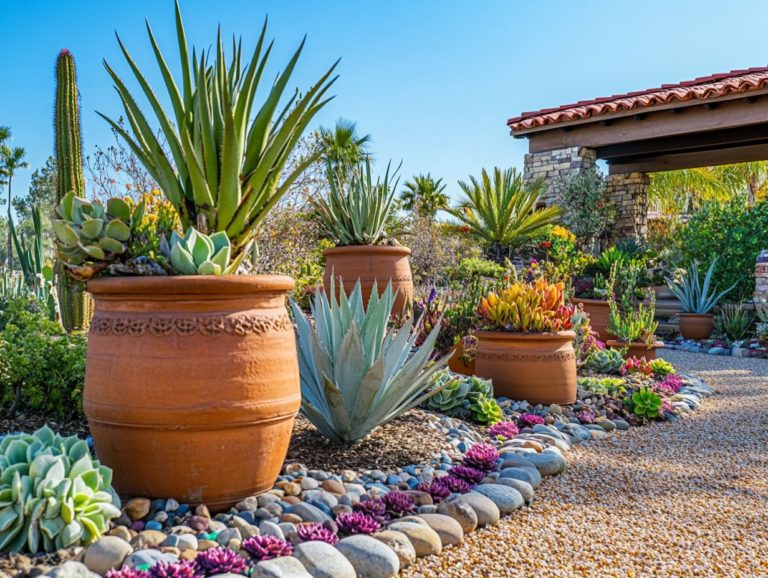A Guide to Drought-Resistant Vegetables
In a world of changing climate and limited water, growing drought-resistant vegetables is essential for sustainable gardening.
These resilient plants conserve water and provide great nutrition. This guide will help you select the best varieties, care tips, and harvesting techniques.
You will also find delicious recipes to make the most of your drought-resistant harvest. Dive into this rewarding journey today!
Contents
- Key Takeaways:
- Understanding Drought-Resistant Vegetables
- Choosing the Right Drought-Resistant Vegetables
- Caring for Drought-Resistant Vegetables
- Harvesting and Storage of Drought-Resistant Vegetables
- Recipes and Meal Ideas Using Drought-Resistant Vegetables
- Frequently Asked Questions
- What are drought-resistant vegetables?
- Why should I plant drought-resistant vegetables?
- What are some examples of drought-resistant vegetables?
- How do I care for drought-resistant vegetables?
- Can I still grow other vegetables in drought conditions?
- Are there any other benefits to growing drought-resistant vegetables?
Key Takeaways:

- Choose drought-resistant vegetables for a resilient garden. Consider your climate and soil when selecting the best options.
- Effective watering and maintenance ensure the success of your plants. Techniques like mulching and drip irrigation help conserve water.
- Harvest and store your vegetables properly for the best flavor. Get creative with recipes and enjoy nutritious meals!
Understanding Drought-Resistant Vegetables
Drought-resistant vegetables are key to sustainable gardens, especially where water is scarce and climate is unpredictable. For more insights, consider creating a drought-resistant vegetable garden. These vegetables thrive in dry conditions, helping to save water and build a resilient ecosystem.
By selecting drought-tolerant varieties, you can enjoy a generous harvest while lessening the environmental impact of traditional gardening. Consider adding okra, Swiss chard, and Jerusalem artichoke to your garden for better adaptation to harsh climates.
Definition and Benefits
Drought-tolerant vegetables thrive in low-water conditions, making them ideal for gardens that focus on water conservation. To ensure you select the best options, consider learning how to choose drought-resistant plants while providing nutritious food options.
These crops are specially adapted to withstand drought and heat, significantly reducing the need for regular watering. By choosing these, you’ll lower water usage and simplify maintenance.
For example, Chinese cabbage and Texas Hill Country squash are both resilient in dry spells. Growing these plants fosters ecological responsibility and promotes sustainable practices while ensuring a good harvest.
Choosing the Right Drought-Resistant Vegetables
Selecting the right drought-resistant vegetables is crucial for successful gardening, especially in areas faced with water scarcity and high temperatures.
Consider soil preparation, sun exposure, and your planting schedule for optimal growth and yield.
Choosing drought-tolerant varieties suited to your conditions leads to a thriving vegetable garden that flourishes with minimal water, promoting the future of drought-resistant gardening practices.
Factors to Consider

When selecting drought-resistant vegetables, consider key factors. These include soil moisture retention, irrigation methods, and your garden’s specific growing conditions, particularly in hot climates. For more detailed guidance, check out how to choose drought-resistant plants for your garden.
If your garden is in an arid region, use specific strategies to help your vegetables survive and thrive.
Evaluating the soil type is essential. Sandy soils drain quickly and might require the addition of organic matter to boost moisture retention. In contrast, clay soils can hold water longer but may become compacted, causing drainage issues and increasing drought stress.
Understanding your local climate patterns, including average rainfall and temperature extremes, will help you choose crops that flourish in those conditions, especially during extreme weather.
Explore different irrigation methods. For example, drip systems deliver water directly to plant roots, promoting sustainable growth.
Caring for Drought-Resistant Vegetables
Caring for drought-resistant vegetables requires effective watering techniques and maintenance strategies that support sustainable gardening. This ensures your plants thrive in challenging conditions.
Regular and deep watering methods help maintain optimal soil moisture while minimizing water waste.
By strengthening the root systems of these vegetables, you promote healthier growth and bolster their drought tolerance. This ultimately makes your garden more resilient against climate change impacts.
Watering and Maintenance Tips
Effective watering and maintenance tips are essential for ensuring the health of your drought-resistant plants. Focus on methods that minimize moisture loss and promote efficient water use.
One effective strategy is using mulch. It reduces evaporation from the soil surface, helping retain moisture for extended periods.
Regular inspections of your garden help spot and control weeds that compete for vital nutrients and water.
Keeping your soil healthy is vital for thriving crops! Incorporating compost and organic matter enriches the soil, making it more resilient to drought conditions.
By combining these practices, you cultivate a thriving ecosystem that supports your drought-resistant crops and enhances overall soil quality, leading to better yields.
Harvesting and Storage of Drought-Resistant Vegetables
Harvesting and storing drought-resistant vegetables demands a nuanced understanding of best practices for optimal results. This prolongs the quality and flavor of your homegrown produce and supports sustainable gardening efforts.
Timing your harvest for peak ripeness significantly enhances both flavor and nutritional value.
Employing effective storage techniques can drastically reduce spoilage and waste. This mindful approach preserves your crop yield and fosters a more sustainable kitchen and lifestyle.
Ensuring your efforts yield delicious, responsibly cultivated vegetables aligns with sustainable gardening practices.
Best Practices for Optimal Results

Implementing best practices for harvesting drought-resistant vegetables will yield optimal results in both quality and quantity. This method preserves your produce’s quality. It also enhances their flavor and nutritional value.
For leafy greens like kale and spinach, aim to harvest them early in the morning for that delightful crispness. A sharp knife is your best ally here, as it helps prevent bruising. For root vegetables like carrots and beets, pull them gently from the soil. This minimizes disturbance to their delicate skin and keeps their root structure intact.
Proper storage is key. While refrigeration can extend freshness, be sure to place your veggies in bags that allow air to flow to avoid moisture build-up. When it s time to cook, consider roasting or saut ing these drought-resistant varieties. Use cooking methods that enhance their flavors, deepening their natural tastes and helping retain those essential nutrients you ve worked so hard to cultivate.
Recipes and Meal Ideas Using Drought-Resistant Vegetables
Exploring recipes and meal ideas featuring drought-resistant vegetables and fruits allows you to showcase your harvest while enjoying nutritious options that are simple to prepare and bursting with flavor.
By incorporating plants that thrive in warm temperatures like chili peppers, figs, and eggplant into your meals, you open the door to diverse culinary experiences that complement sustainable gardening practices.
Use cooking methods that highlight the natural tastes and textures of these vegetables and edible fruits. This enables you to savor healthy, homegrown dishes that not only enhance your well-being but also benefit the environment.
Delicious and Nutritious Options
Exciting and nutritious meals await with drought-resistant vegetables! These resilient plants flourish in arid conditions, presenting delightful tastes and vivid colors that can transform your everyday dishes.
For example, varieties like okra and eggplant bring a subtle nuttiness that pairs exquisitely with Southern-style cooking, while Swiss chard adds a vibrant touch with its earthy undertones, showcasing the benefits of growing vegetables suited for drought conditions.
To unlock their unique profiles, consider roasting them with olive oil and herbs, or tossing them into stir-fries for a quick, wholesome meal. By weaving these vegetables into your weekly menu, you not only enrich your diet with nutrient-packed ingredients but also embrace sustainable practices, fostering a more eco-friendly lifestyle.
Frequently Asked Questions
What are drought-resistant vegetables?

Drought-resistant vegetables are types of vegetables that have the ability to survive and thrive in dry conditions. For more information on how to cultivate these plants effectively, check out our guide on drought gardening: tips for sustainable practices. They have adapted to conserve water and can withstand extended periods of low moisture levels.
Why should I plant drought-resistant vegetables?
Planting drought-resistant vegetables can help you save water in times of drought and conserve the environment. For those with limited space, exploring drought-resistant gardening for small spaces is a great option. They also require less maintenance and are generally hardier, making them easier to grow.
What are some examples of drought-resistant vegetables?
Some examples of drought-resistant vegetables include eggplants, tomatoes, peppers, kale, collard greens, and sweet potatoes. To learn more about growing these plants, you can check out how to get started with drought-resistant gardening. These vegetables have deep root systems that help them access water from deeper soil layers.
How do I care for drought-resistant vegetables?
Drought-resistant vegetables still require regular watering, especially during the early stages of growth. However, they can withstand longer periods without water. It is important to mulch around the vegetables to help retain moisture and keep weeds at bay.
Start your sustainable garden today and enjoy the many benefits of drought-resistant vegetables!
Can I still grow other vegetables in drought conditions?
Yes, you can grow vegetables even in drought conditions. They will, however, need more water and care.
Are there any other benefits to growing drought-resistant vegetables?
Drought-resistant vegetables save water and are easier to grow. They are also generally more resistant to pests and diseases. Choosing these vegetables not only benefits your garden but also helps the environment!






